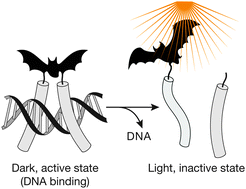Ruthenium bipyridyl complexes as photocleavable dimerizers: deactivation of DNA-binding peptides using visible light†
Abstract
We report a photolabile biselectrophilic Ru(II) complex that can be used for homo- or heterodimerization of cysteine-containing peptides. The resulting dimers can be efficiently disassembled by long-wavelength light. As proof-of-concept, we describe the preparation of homo- and heterodimeric bZIP peptides whose DNA-binding properties can be turned off using visible light.


 Please wait while we load your content...
Please wait while we load your content...